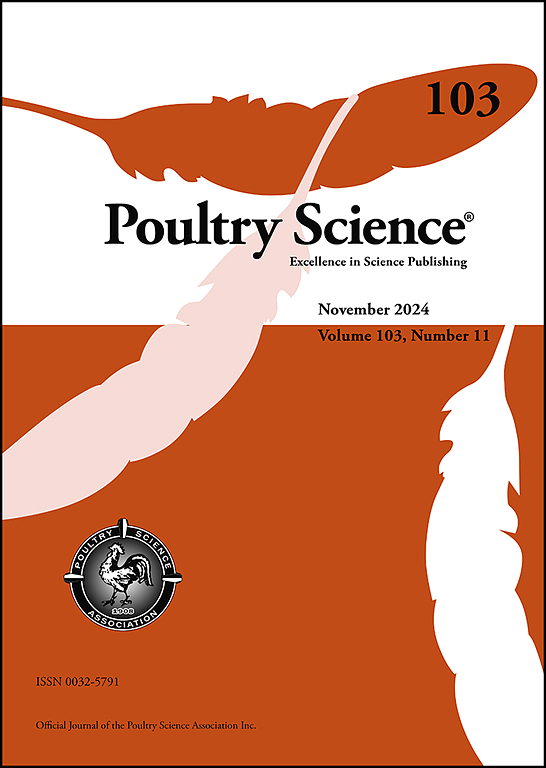Interactive effects of dietary deoxynivalenol and coccidial infection on growth performance, immune response, oxidative status, and gut health in pullets
IF 4.2
1区 农林科学
Q1 AGRICULTURE, DAIRY & ANIMAL SCIENCE
引用次数: 0
Abstract
Deoxynivalenol (DON) contamination of grains and coccidiosis are two major health and economic challenges in layer production, yet their combined effect during pullet rearing phase remains poorly understood. This study evaluated whether dietary DON exposure exacerbates the severity of Eimeria infection and delays recovery in growing pullets. A total of 288 Hy-Line W36 pullets (4-wk-old) were fed either a control diet containing 2.5 mg/kg DON or a naturally contaminated diet containing 14-15 mg/kg DON for 14 d. Birds were then sham‑dosed or orally inoculated with E. acervulina (50 000 oocysts), E. maxima (10 000) and E. tenella (10 000) in a 2 × 2 factorial design. Growth performance, gut permeability, intestinal morphology, jejunal tight‑junction and mucin gene expression, cecal tonsil cytokine profiles, T‑cell subsets, and hepatic redox indices were analyzed at 6 and 14 days post inoculation (DPI). DON alone did not depress weight gain; however, when coupled with Eimeria challenge it reduced feed intake by an additional 3 % (P = 0.038) and numerically aggravated intestinal lesions. The Eimeria challenge reduced body weight by 15 % at 6 DPI and 8 % at 14 DPI (P < 0.001), increased gut permeability and disrupted intestinal architecture (P < 0.001). Eimeria also damaged gut barrier integrity and induced Th1‑biased inflammation by downregulating JAM2, OCLN, ZO1 and MUC2 while upregulating CLDN1, IFN‑γ and IL‑10 (P < 0.05). DON independently downregulated jejunal MUC2 and upregulated IL‑1β. The interaction delayed mucosal repair and immune dysregulation by further upregulating CLDN1 at 14 DPI (P = 0.004) and splenic CD4⁺ cells at 6 DPI (P = 0.003). Hepatic redox indices were independently affected by Eimeria at 6 and 14 DPI, whereas DON at 14 DPI. In conclusion, diets containing 14-15 mg/kg DON negatively affected the immune response and jejunal MUC2 expression with minimal adverse effects on growth in non-challenged pullets. However, when Eimeria infection was present, DON delayed gut repair and shifted immune balance toward inflammation. Therefore, routine mycotoxin surveillance and mitigation in pullet feeds are important, especially in cage‑free systems where Eimeria spp. often circulate subclinically, to prevent downstream negative effects on laying performance and profitability.
饲料中脱氧雪腐镰刀菌醇和球虫感染对小鸡生长性能、免疫反应、氧化状态和肠道健康的交互影响
籽粒脱氧雪腐镰刀菌醇(DON)污染和球虫病是蛋鸡生产中的两大健康和经济挑战,但它们在雏鸡饲养阶段的综合影响尚不清楚。本研究评估了饮食中的DON暴露是否会加剧艾美耳球虫感染的严重程度并延迟生长中的小鸡的恢复。288只海兰W36雏鸡(4周龄)分别饲喂含有2.5 mg/kg DON的对照饲粮和含有14-15 mg/kg DON的自然污染饲粮,为期14天。然后,在2 × 2因子设计中,给雏鸡假剂量或口服接种针状芽胞杆菌(5万个卵囊)、最大芽胞杆菌(10万个)和tenella芽胞杆菌(10万个)。在接种后6和14天(DPI)分析生长性能、肠道通透性、肠道形态、空肠紧密连接和粘蛋白基因表达、盲肠扁桃体细胞因子谱、T细胞亚群和肝脏氧化还原指数。单靠DON并不能抑制体重增加;然而,当与艾美耳球虫攻毒相结合时,采食量额外减少3% (P = 0.038),肠道病变数量加重。艾美耳球虫攻击使体重在6 DPI时减少15%,在14 DPI时减少8% (P <;0.001),肠通透性增加和肠道结构破坏(P <;0.001)。艾美耳球虫还通过下调JAM2、OCLN、ZO1和MUC2而上调CLDN1、IFN - γ和IL - 10来破坏肠道屏障完整性并诱导Th1偏倚性炎症(P <;0.05)。DON独立下调空肠MUC2和上调IL - 1β。通过进一步上调CLDN1在14 DPI (P = 0.004)和脾CD4 +细胞在6 DPI (P = 0.003),这种相互作用延迟了粘膜修复和免疫失调。在6和14 DPI时,肝氧化还原指数分别受艾美耳球虫的影响,而在14 DPI时,肝氧化还原指数受DON的影响。综上所述,饲粮中添加14-15 mg/kg DON会对未攻毒雏鸡的免疫应答和空肠MUC2表达产生负面影响,对雏鸡生长的不利影响最小。然而,当艾美球虫感染存在时,DON会延迟肠道修复并将免疫平衡转向炎症。因此,对雏鸡饲料进行常规霉菌毒素监测和缓解是很重要的,特别是在无笼系统中,艾美耳球虫经常在亚临床循环,以防止对产蛋性能和盈利能力产生下游负面影响。
本文章由计算机程序翻译,如有差异,请以英文原文为准。
求助全文
约1分钟内获得全文
求助全文
来源期刊

Poultry Science
农林科学-奶制品与动物科学
CiteScore
7.60
自引率
15.90%
发文量
0
审稿时长
94 days
期刊介绍:
First self-published in 1921, Poultry Science is an internationally renowned monthly journal, known as the authoritative source for a broad range of poultry information and high-caliber research. The journal plays a pivotal role in the dissemination of preeminent poultry-related knowledge across all disciplines. As of January 2020, Poultry Science will become an Open Access journal with no subscription charges, meaning authors who publish here can make their research immediately, permanently, and freely accessible worldwide while retaining copyright to their work. Papers submitted for publication after October 1, 2019 will be published as Open Access papers.
An international journal, Poultry Science publishes original papers, research notes, symposium papers, and reviews of basic science as applied to poultry. This authoritative source of poultry information is consistently ranked by ISI Impact Factor as one of the top 10 agriculture, dairy and animal science journals to deliver high-caliber research. Currently it is the highest-ranked (by Impact Factor and Eigenfactor) journal dedicated to publishing poultry research. Subject areas include breeding, genetics, education, production, management, environment, health, behavior, welfare, immunology, molecular biology, metabolism, nutrition, physiology, reproduction, processing, and products.
 求助内容:
求助内容: 应助结果提醒方式:
应助结果提醒方式:


